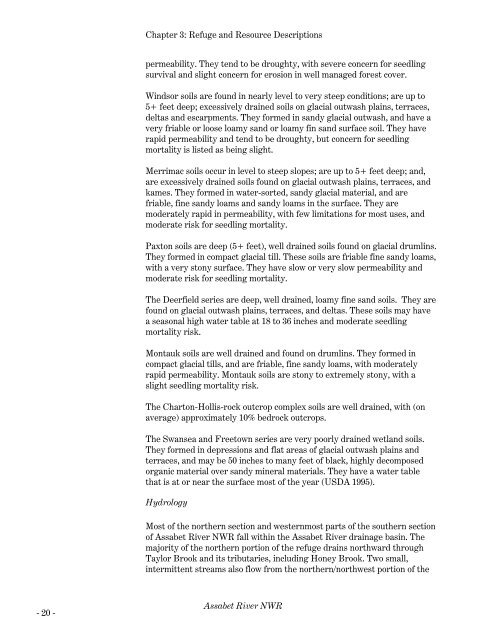Assabet River NWR Final CCP - U.S. Fish and Wildlife Service
Assabet River NWR Final CCP - U.S. Fish and Wildlife Service
Assabet River NWR Final CCP - U.S. Fish and Wildlife Service
You also want an ePaper? Increase the reach of your titles
YUMPU automatically turns print PDFs into web optimized ePapers that Google loves.
- 20 -<br />
Chapter 3: Refuge <strong>and</strong> Resource Descriptions<br />
permeability. They tend to be droughty, with severe concern for seedling<br />
survival <strong>and</strong> slight concern for erosion in well managed forest cover.<br />
Windsor soils are found in nearly level to very steep conditions; are up to<br />
5+ feet deep; excessively drained soils on glacial outwash plains, terraces,<br />
deltas <strong>and</strong> escarpments. They formed in s<strong>and</strong>y glacial outwash, <strong>and</strong> have a<br />
very friable or loose loamy s<strong>and</strong> or loamy fin s<strong>and</strong> surface soil. They have<br />
rapid permeability <strong>and</strong> tend to be droughty, but concern for seedling<br />
mortality is listed as being slight.<br />
Merrimac soils occur in level to steep slopes; are up to 5+ feet deep; <strong>and</strong>,<br />
are excessively drained soils found on glacial outwash plains, terraces, <strong>and</strong><br />
kames. They formed in water-sorted, s<strong>and</strong>y glacial material, <strong>and</strong> are<br />
friable, fine s<strong>and</strong>y loams <strong>and</strong> s<strong>and</strong>y loams in the surface. They are<br />
moderately rapid in permeability, with few limitations for most uses, <strong>and</strong><br />
moderate risk for seedling mortality.<br />
Paxton soils are deep (5+ feet), well drained soils found on glacial drumlins.<br />
They formed in compact glacial till. These soils are friable fine s<strong>and</strong>y loams,<br />
with a very stony surface. They have slow or very slow permeability <strong>and</strong><br />
moderate risk for seedling mortality.<br />
The Deerfield series are deep, well drained, loamy fine s<strong>and</strong> soils. They are<br />
found on glacial outwash plains, terraces, <strong>and</strong> deltas. These soils may have<br />
a seasonal high water table at 18 to 36 inches <strong>and</strong> moderate seedling<br />
mortality risk.<br />
Montauk soils are well drained <strong>and</strong> found on drumlins. They formed in<br />
compact glacial tills, <strong>and</strong> are friable, fine s<strong>and</strong>y loams, with moderately<br />
rapid permeability. Montauk soils are stony to extremely stony, with a<br />
slight seedling mortality risk.<br />
The Charton-Hollis-rock outcrop complex soils are well drained, with (on<br />
average) approximately 10% bedrock outcrops.<br />
The Swansea <strong>and</strong> Freetown series are very poorly drained wetl<strong>and</strong> soils.<br />
They formed in depressions <strong>and</strong> flat areas of glacial outwash plains <strong>and</strong><br />
terraces, <strong>and</strong> may be 50 inches to many feet of black, highly decomposed<br />
organic material over s<strong>and</strong>y mineral materials. They have a water table<br />
that is at or near the surface most of the year (USDA 1995).<br />
Hydrology<br />
Most of the northern section <strong>and</strong> westernmost parts of the southern section<br />
of <strong>Assabet</strong> <strong>River</strong> <strong>NWR</strong> fall within the <strong>Assabet</strong> <strong>River</strong> drainage basin. The<br />
majority of the northern portion of the refuge drains northward through<br />
Taylor Brook <strong>and</strong> its tributaries, including Honey Brook. Two small,<br />
intermittent streams also flow from the northern/northwest portion of the<br />
<strong>Assabet</strong> <strong>River</strong> <strong>NWR</strong>

















